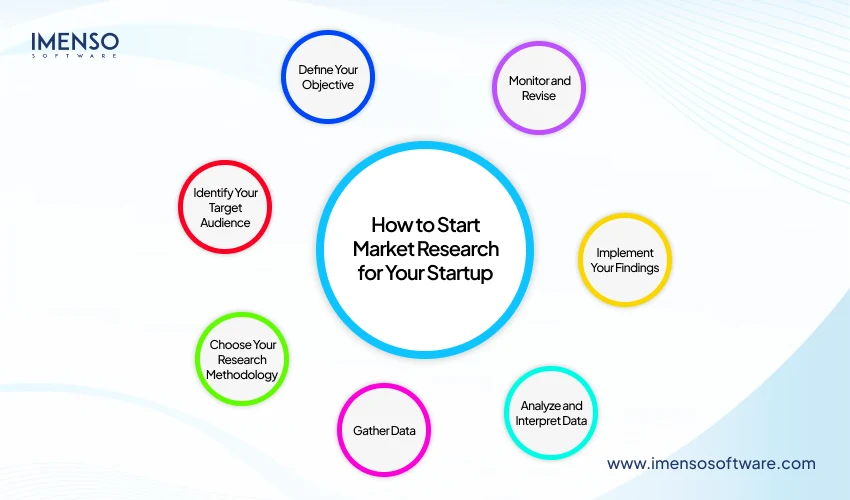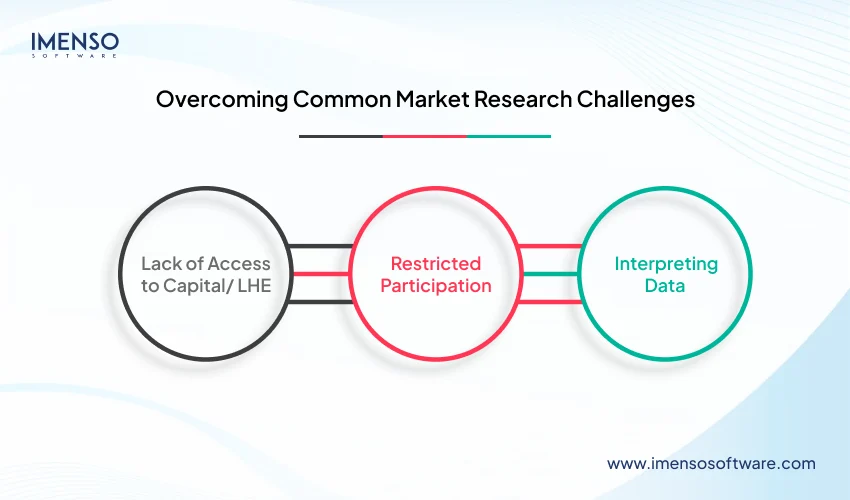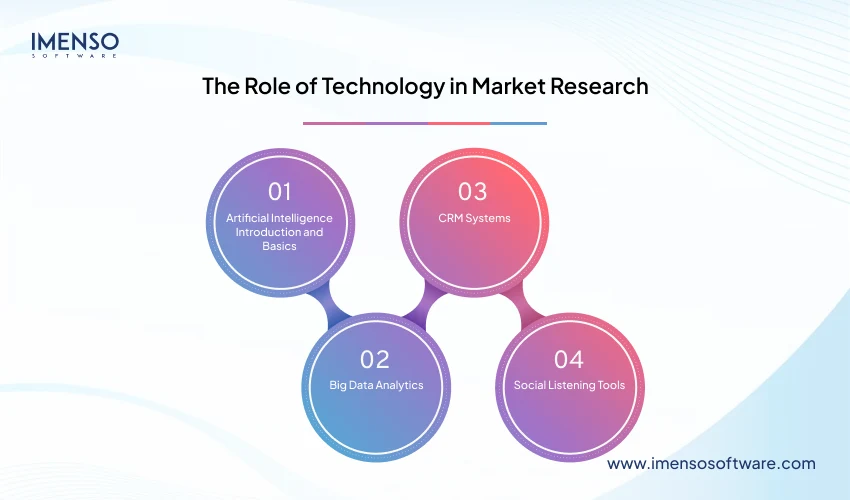Conducting Market Research: A Comprehensive Guide for Startups

Are you truly understanding your market research for startups? Feeling rather lost when you start a new business venture is quite natural. There are so many pitfalls that occur in the course of a startup business, such as knowing their targeted market.
Inventing gadgets without users or creating advertisement campaigns that do not attract the required audience is unprofitable. Here’s a startling statistic: 35% of startups fail This just goes to show the need to carry out proper market research for startups before devising major business strategies.
Here in this startup research guide, we will seek to understand the steps of market research for startups, the need for such research, and the actual steps needed to conduct efficient research that will give essential results. No matter if you want to build a competitive edge, thinking of introducing a new service or product into the market, or developing and improving the existing one, market research can prove beneficial.
What Is Market Research For Startups and Why Does It Matter?
Market research for startups is the systematic process of gathering, analyzing, and interpreting information about a market, including its target customers, competitors, and trends. It helps businesses answer crucial questions like:
- Who are our customers, and what do they need?
- How do our competitors operate?
- What trends are shaping our industry?
These insights for startups can be used in conceptualizing their products and pricing, advertising, coming up with market analysis, penetration strategies, and more.
Types of Market Research
Market research for startups can be categorized into two primary types:
Primary Research
This includes capturing new data from the sources. Techniques include:
- Surveys
- Focus groups
- One-on-one interviews
- Observational studies
Secondary Research
This includes data mining on already collected data from published reports, books, Journals, government publications, and data in online databases. It is affordable, and you get a wide overview of market conditions and the activity of competitors.
How To Conduct Market Research For Startups

Here’s a step-by-step guide to help you navigate the process:
Step 1: Define Your Objective
Start by identifying why you’re conducting research. Are you looking to:
- Test a new product idea?
- Understand customer pain points?
- Explore a new market?
Knowledge of your goal will help you avoid time waste and help you stay on track when collecting data.
Step 2: Identify Your Target Audience
The core of the market research for startups is your target audience. Develop customer profiles that address demographic, behavioral, preference, and concern characteristics. It also prevents you from collecting a lot of data without any value to research. Whether you are a software development company designing mobile applications or a tech-based firm, the identification of a target audience is very crucial.
Step 3: Choose Your Research Methodology
Decide whether you’ll rely on primary or secondary research—or a mix of both. For startups with limited budgets, secondary research can be an affordable starting point. However, primary research offers insights tailored to your specific needs.
Step 4: Gather Data
Leverage tools and platforms such as:
- Online surveys through platforms like SurveyMonkey or Google Forms.
- Social media analytics to understand customer research, preferences, and behavior.
- Competitor analysis tools like SEMrush or Ahrefs to gather insights on your rivals.
For businesses interested in exploring global markets, partnering with experts in Offshore e-commerce Development Services can provide invaluable insights tailored to your industry.
Step 5: Analyze and Interpret Data
If you use qualitative data, after you collect your material, classify it as useful information. Seek for similarities and differences, and look for relationships. You can also use tools such as Excel, Tableau, Power BI for data-driven insights, or Google Data Studio.
Step 6: Implement Your Findings
Those insights that can not be implemented in an organization have little or no value at all. These findings can then be utilized to make improvements to your product, upgrade or focus your advertising approach, or find a new path to expansion.
Step 7: Monitor and Revise
They are conditional to the fact that market conditions are constantly in a state of change. It is good practice to review this work periodically so that when you consider your strategies, they are up to date.
Tools and Resources for Comprehensive Market Research Strategies
Here are some tools that can streamline the process of comprehensive market research strategies:
Google Trends – For the trend of the search and interests of the customers.
Statista – To obtain information by focusing on a specific industry to get detailed reports.
Qualtrics – It is a more feature-fused tool for creating surveys and getting comprehensive reports.
Ahrefs – For keyword research and analysis Overall Competitor Analysis Image Identification Facebook Graph Search BuzzFeed – As a content research tool and for monitoring trends and competitors.
HubSpot – Customer research, to track customers’ behavior and be the CRM.
Real-World Example: How Market Research Drives Success
Consider a startup looking to enter the eCommerce space. Through detailed market research, they uncover the following:
- Customers prioritize fast shipping and user-friendly interfaces.
- Competitors are heavily investing in mobile apps.
- Sustainability is a growing concern among their target audience.
Equipped with those uncertainties, the startup works with specialists in Offshore e-commerce Development Services to create a sustainable, mobile-first application. This makes them unique from the rest of the companies and also goes well with their target market.
Overcoming Common Market Research Challenges

Lack of Access to Capital/ LHE
Start-up companies usually lack adequate capital funds. For example, free tools like Google Analytics can be used to perform low-cost surveys in order to get value-added information.
Restricted Participation
Draw these respondents from your social media contacts, subscribers, or any internet groups for your surveys or interviews.
Interpreting Data
Data on their own can be very misleading. Consult widely with specialists to get the correct interpretation of your results.
For insights on creating effective marketing campaigns, check out our guide on How To Create A Social Media Marketing Strategy For Your Business.
The Role of Technology in Market Research

In the current world, developing new products is easier with the advanced instruments that are easily accessible by startups. Getting data becomes easier if the right technology to support the process is employed, and this leads to the development of better insights. Here are some examples of how technology is transforming the market research for startups:
Artificial Intelligence Introduction and Basics
AI methods can also identify correlations that are usually missed. For instance, in text classification, AI can assist startups on matters regarding the perception that people hold for their products or brands through sentiment analysis from social media and related platforms.
Big Data Analytics
Google Analytics, Power BI, Adobe Analytics, and other big data tools to track a large amount of data for startups. From the data collected in the different channels, you can get user insights, conversion rates, and sales, thus forming your market research.
CRM Systems
Salesforce or Hubspot customer relationship management systems give you most of the required information about your customers. They also allow you to monitor interactions with leads and customers besides categorizing your audiences through demographics, interests, and behavior. The gathered information can enhance marketing approaches in the future and support changing the course of business and its actions.
Social Listening Tools
Social media accounts represent a real treasure trove of information. From Hootsuite, Brandwatch, Sprout Social, and others, you can track conversations about your brand and competitors. There are social listening tools that aid in monitoring mentions, finding influential users to introduce to your brand, and measuring the sentiment of different avenues in real-time reporting, allowing for the understanding of market relevancy.
Also read:
Power BI Professional Services: Elevating Your Business Intelligence Strategy
Adjusting Your Product Roadmap in Response to Market Changes
Product Roadmap for Startups: Aligning With Your Business Strategy
Final Thoughts
The startup journey is filled with uncertainty, but one thing is certain: proper market research for startups can boost your chances of success to an incredible level. It means that there is a possibility for the right decision, the best choice of market and customer, and the lowest risk of the competitors.
Imenso Software appreciates the problems that startups come across when they are attempting to manage their markets. Our expert has a pool of dedicated and experienced setters and software developers to help you with your market study. Depending on what goal you have – being a B2B company wanting to polish its products or a startup that strives for growth, we will be able to assist.
Last but not least, do not simply rely on what we have said here – visit our Clutch profile to find out what other businesses’ outcomes were.
FAQs
Why is market research for startups important?
Market research aids new ventures in their quest to establish the needs of their clientele, the competition, and trends in the marketplace. This information helps to minimize the risks and maximize the prospect of success by providing that all decisions are based on the available data.
What are the most common methods of market research?
The two principal modes of reaching the consumer are primary research which includes surveys, interviews, and focus groups, and secondary research which involves the use of published data such as reports and studies.
What are the resources that can be used by startup firms to gather market information cheaply?
There are several free resources that can be used including; Google Analytics, Social Media Statistics, and Survey Monkey among others.
How often should startups get into the world of updating market research?
Startups are recommended to make a SWOT analysis on a quarterly or annual basis so that your business remains relevant to the customer needs, industry dynamics, and competitors’ activity.
In what way can market research help a startup enhance its marketing strategy?
Market research gives information about the customer’s attitudes, expectations, and frustrations. This is a big advantage for startups to build campaigns that are unique to the business, reach the right clients, and ultimately increase the return on investment.
Want more information about our services?
Similar Posts

Offshore vs. Nearshore vs. Onshore Development: What’s Best for Scaling Startups?
Startup entrepreneurs find building an effective development team at affordable prices challenging. The executives must choose between working with local developers or overseas workers. Also, it’s tough to choose between domestic developers and overseas outsourcing. But, this will help you optimize price, quality maintenance, and team bonding. WhatsApp represents a successful company whose operations significantly […]...

Dynamic Pricing: How Startups Can Adapt to Market Changes
Uber had a serious issue in 2016. Prices went up during rush hours or bad weather. Riders were unhappy. But Uber made a smart move. They changed their pricing system. They made it clearer and fairer. Drivers still got good pay, and riders felt it was fair. This helped Uber keep its customers happy. It […]...

Top 10 Cost Control Strategies for Startups
Are you struggling to manage your startup’s finances while still focusing on growth? Cost control is an essential factor in new business since it differentiates between success and failure. According to the study, funding emerges as the leading cause of startup failure among new businesses, with a figure of 28.2%. Nevertheless, this statistic shows the […]...









